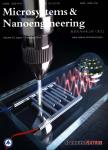An electronic nose using a single graphene FET and machine learning for water, methanol, and ethanol
作者机构:Berkeley Sensor and Actuator Center&Department of Mechanical EngineeringUniversity of California at BerkeleyBerkeleyCA 94720USA Materials Science and Engineering ProgramCollege of ScienceUniversity of the Philippines Diliman1101 Quezon CityPhilippines National Institute of PhysicsCollege of ScienceUniversity of the Philippines Diliman1101 Quezon CityPhilippines
出 版 物:《Microsystems & Nanoengineering》 (微系统与纳米工程(英文))
年 卷 期:2020年第6卷第1期
页 面:969-981页
核心收录:
学科分类:0808[工学-电气工程] 0809[工学-电子科学与技术(可授工学、理学学位)] 0817[工学-化学工程与技术] 080202[工学-机械电子工程] 08[工学] 0807[工学-动力工程及工程热物理] 0805[工学-材料科学与工程(可授工学、理学学位)] 0802[工学-机械工程] 0811[工学-控制科学与工程] 0702[理学-物理学]
基 金:This work was supported in part by PCARI(Philippine-California Advanced Research Institutes),an NSF grant-ECCS-1711227,BSAC(Berkeley Sensor and Actuator Center) the Leading Graduate School Program R03 of MEXT.These devices were fabricated at the UC Berkeley Marvell Nanofabrication Lab
主 题:methanol selectivity electronic
摘 要:The poor gas selectivity problem has been a long-standing issue for miniaturized chemical-resistor gas *** electronic nose(e-nose)was proposed in the 1980s to tackle the selectivity issue,but it required top-down chemical functionalization processes to deposit multiple functional ***,we report a novel gas-sensing scheme using a single graphene field-effect transistor(GFET)and machine learning to realize gas selectivity under particular conditions by combining the unique properties of the GFET and e-nose *** of using multiple functional materials,the gas-sensing conductivity profiles of a GFET are recorded and decoupled into four distinctive physical properties and projected onto a feature space as 4D output vectors and classified to differentiated target gases by using machine-learning *** single-GFET approach coupled with trained pattern recognition algorithms was able to classify water,methanol,and ethanol vapors with high accuracy quantitatively when they were tested ***,the gas-sensing patterns of methanol were qualitatively distinguished from those of water vapor in a binary mixture condition,suggesting that the proposed scheme is capable of differentiating a gas from the realistic scenario of an ambient environment with background *** such,this work offers a new class of gas-sensing schemes using a single GFET without multiple functional materials toward miniaturized e-noses.



